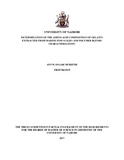| dc.description.abstract | Whereas marine fish processing in Kenya is on one hand an important contributor to Kenya’s food
production and economy, it is on the other hand a source of bio waste disposed to the environment.
Most of the by products, including fish skin, scales and bones, which are disposed as waste, can
be utilized in the making of important products hence eliminating the environmental menace they
pose. This study sought to utilize scales in the extraction of the protein gelatin. Gelatin in this study
was extracted by an enzymatic process from the scales of three marine fish species; Lutjanus sebea
(Red snapper), Lethrinus harak (Black spot emperor) and Scalus ghobban (Blue barred parrot
fish). Concentration of the bacteria, Bacillus cereus, for mass production of enzyme was done in
a fermentation medium using a bio reactor. Scales were hydrolysed at 45ºC and the pH maintained
at 12. Complete hydrolysis took between 20 and 23 days for all species. The yield for dry gelatin
was between 28.2% and 41.4% for the marine fish scales under study. Fourier transform infrared
spectra showed the presence of amide bands and two other additional absorption bands indicating
the presence of amide bonds for all the three fish species under study. The amino acid composition
analysis for gelatin obtained from the fish species showed the presence of 16 amino acids. Glycine
was the most abundant (35%), followed by Alanine, both adding up to around 50% of the total
amino acid composition for all three marine fish species studied. Proline was higher for red snapper
at over 14.2% compared to 11.1% and 11.6% for blue barred parrot fish and black spot emperor
respectively. Polymer blends of three different compositions were prepared comprising of gelatin
obtained from blue barred parrot fish scales and PLA. Thermal analysis of these polymer blends
was conducted via TGA and DSC. Miscibility and compatibility were confirmed but were
dependent on PLA/gelatin composition. The good yield of gelatin obtained in this study shows
that alkaline protease was effective in the extraction of gelatin from the scales of the three marine
fish species and that the scales are suitable sources of gelatin. This study also showed an
improvement caused by polymer blending with the TGA analysis of the three polymer blends of
amorphous PLA and gelatin showing slower rates of thermal decomposition than either of the
polymers before blending. | en_US |



